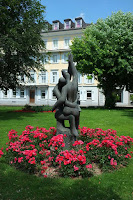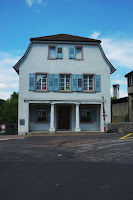I bought my current EOS 5D MKII just after the Mark 3 was introduced. This has the benefit of being "field tested" by thousands of users and being able to read their opinions. It also means that dealers will want to clear their shelves to make way for the latest model.
By the time I buy a new piece of kit, I will have read everything I can about it and therefore will be able to make an informed buying decision.
I saw my latest acquisition when it first came out in 2010 and immediately wanted it! It looked good and reminded me of my early eager years in photography. A time when not too many folks had zoom lenses and there were parallax correction indicators in the viewfinder.
I'm talking about the Fujifilm X100 range finder camera. 'Tis a thing of beauty and a joy to behold.
I'm not going to do an in depth test here as there are plenty of other people doing that all over the 'net
The day I received the camera (which I got for a very good price from an auction website), I spent just looking at it! It really is a joy to look at and feels good. All the controls fall easily to hand and anything that you set manually on the body can be seen in the very informative viewfinder window.
It has three auto modes. If you want shutter priority, you set the lens aperture dial to A. If you want aperture priority then the shutter speed dial must be set to A. For fully programmed, you have to set both the aperture and the shutter speed dials to A. For fully manual just pick and choose your own aperture and speed. The viewfinder will tell you how far off you are with a plus / minus bar on the left.
The camera is fitted with the 35mm full frame equivalent of a 35mm semi wide angle lens. No zooming here. You either stick to landscapes, groups or get in close! If you have read my blog in any depth or you know me personally, you will be aware that I dislike lens caps! I just don't like them. The first thing I wanted to do with the camera was to hide the lens cap away but that left the front element of the lens exposed. There is no filter ring on the lens so you have to buy an adapter ring.
The price of original Fujifilm accessories is, in my opinion, extortionate so I bought a JJC filter ring adaptor together with a clone lens hood for about Fr 20 ($21 or £13). Fuji want $70 for the equivalent.
I found the 35mm angle of view to be a bit restricting when I was out hiking so I invested in a screw on lens which converts it to a 28mm. The optical results are good enough for me and my clients. The hood is deep enough to keep anything from making contact with the lens.
The JJC cloned lens hood
The JJC cloned lens hood with the wide angle adapter
This is a "direct from camera" panorama image
As mentioned earlier, there are lots of reviews for the camera on the 'net. I just wanted to write about how happy I am with it. It looks good, feels great in the hand and turns out more than adequate results. The only two minor niggles I have with this piece of kit are the RAW conversion software which I find clunky and cumbersome and the exposure compensation dial which sometimes gets inadvertently moved when the camera is slung over my shoulder.
All in all, it's a great piece of kit that puts the fun back into photography.
I take mine everywhere.
Thanks for reading.

























%2B500%2Bsec%2B%40f5.6%2B6400%2BISO.JPG)
%2B04%2Bsec%2B%40f11%2B200%2BISO.JPG)


































